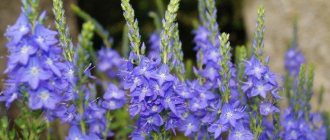It’s not difficult to create a beautiful hedge, close an unattractive fence, or add bright colors to a flowerbed: you need to plant Foxglove. Tall and low plants with pyramidal inflorescences and multiple leaves look impressive in any corner of the garden and summer cottage.
Flower growers believe that there are few plants as unpretentious as Foxglove. Planting and care in open ground, methods of propagation, autumn care, popular varieties, photos, disease prevention, pest control - these and many other useful questions are covered in the article.
Foxglove: types and varieties for open ground
Features of the plant:
- family Plantainaceae;
- traditional and hybrid varieties;
- perennial;
- unpretentious plant: grows well both in the shade and in sunny areas;
- honey plant with aromatic odor;
- side shoots practically do not branch;
- rigid erect stems, height – from 30 cm to 1.5 m;
- leaves are lanceolate or oval in shape, forming a basal rosette in the lower part of the stem;
- the upper part of the leaf blades is shiny, the lower part has a edge, the shade is bluish or silver;
- the inflorescences have the shape of a brush, the flowers look like a bell. In some species, the lower petal is elongated, bent, similar to the “lip” of Snapdragon;
- flowering begins with the opening of the lower buds, the upper ones bloom later, which gives the plant an original appearance against the background of contrasting shades of different parts of the inflorescence;
- there are often dots of a contrasting shade on the throat. Base color: red, pink, lilac, white, light lemon, yellow;
- the seeds are small, located in a box, the color is light brown;
- highly decorative: Foxglove is often used to create hedges or tall flowers are planted along the fence to hide the shortcomings of homemade structures.
Popular varieties of Foxglove:
- Purple.
- Woolly.
- Large-flowered.
Interesting varieties:
- Merton.
- Pam's Choice Split Corolla.
- Tapsi.
- Pam's Choice.
- Alba.
- Silver Fox.
- Solwood summer.
- Hybrids F1 Camelot.
- Candy Mountain.
- Apricot.
- Primrose Carousel.
Useful properties of the plant
Digitalis is actively used in alternative medicine. Even in ancient times, remedies were prepared on the basis of this plant for the treatment of abdominal or thoracic dropsy, skin diseases and constipation. But these drugs must be used with extreme caution, because side effects of treatment, such as vomiting, diarrhea and even death, cannot be ruled out.
Substances such as gitoxin, laatosides, and digitoxin were found in the foliage of the plant. In total, the foliage from the annual plant contains 62 glycosides. This explains why the plant is used in the treatment of cardiovascular diseases. Taking drugs based on digitalis helps improve the condition of the walls of blood vessels, help get rid of atrial fibrillation, tachycardia, myocardial dystrophy, etc.
Woolly digitalis is of greatest value for the preparation of medicines. Next comes the purple, eyelashed, and rusty look.
All varieties of foxglove are poisonous and dangerous to humans. Therefore, you cannot self-medicate with digitalis.
Growing from seeds to seedlings
In regions with a temperate climate, seeds are first sown in containers or wooden boxes, after which the grown seedlings are planted in the ground on the site. To speed up the germination of planting material, the “grains” are soaked in warm water; the procedure lasts three days. It is important to change the water several times during this period. Treatment with Kornevin is also useful. The growth stimulator not only activates the swelling process, but also has a positive effect on the condition of future plants.
Soil and container
Wooden boxes, peat pots or containers with compartments - each type of container has its own advantages. You should not take very deep containers.
Soil for seedlings is a mixture of fine-grained sand and peat. You cannot press the planting material deeply: you will have to wait a long time for the first shoots to appear. Be sure to cover the container with film or glass to create a small greenhouse to retain moisture. As soon as the seeds germinate, gradually (over 5–6 days) open the container with the seedlings, first for ventilation, then for free growth without shelter.
Seedling care
On a note:
- The sprouts grow slowly.
- It is useful to provide additional light to the seedlings if there is not enough natural light.
- Watering is moderate, it is better to spray.
- The temperature is maintained at +20..+22 degrees to avoid extreme heat.
- Dampness in the room is harmful to seedlings: the sprouts begin to rot.
- Do not keep a container with young foxgloves in a draft.
Transplanting
Transplantation of grown seedlings into the garden is carried out in the absence of frost, after the soil has been well warmed up. In most regions, the optimal period is the end of May. A distance of 15 cm is maintained between adjacent specimens: dense plantings are the cause of poor growth
Planting seeds in open ground
A suitable method for regions where spring is early and summer is warm. Light and loose soil is a prerequisite for good foxglove growth.
If the soil is loamy and dense, then add sand and peat to increase the nutritional value and looseness of the substrate. The components are added before digging the earth. It is important to break up the clods and loosen the substrate. It is useful to water the soil with a solution of potassium permanganate for disinfection.
Sowing time
It is important that it is warm outside and there is no threat of frost. The right time is the end of May. Previously, it was not worth sowing “seeds” even in the southern regions.
Choice of location and lighting
Foxglove grows well in open, sunny or light shade areas. Plants with pyramidal inflorescences are not planted under fruit trees in the garden: under the dense crown it is too damp and dark, and in the fall fallen leaves will cover the plantings and rot.
The area should not be swampy: excess moisture leads to the development of mold on the leaves and soil. Powdery mildew is a dangerous disease that develops on a beautifully flowering plant with excessive humidity.
Landing rules
Important details:
- the optimal distance between neighboring plants is 15 cm or more. Thickened plantings interfere with the development of decorative appearance and abundant flowering;
- sow small seeds in calm weather, when there are clouds in the sky and the sun does not send scorching rays to the ground all day long;
- rain or fog is a reason to postpone the planting of foxgloves to another day;
- the seeds are placed on the surface of the soil; small depressions can be made (up to 1 cm). Next, the planting material is sprinkled with substrate, the area is sprayed, but not flooded;
- After germination, the seedlings are cared for: weeding, watering, and destruction of weeds. In dry times, you can mulch the soil around young plants with straw or peat to retain moisture. Under a layer of natural mulch, weeds grow weaker: this fact is confirmed by many gardeners.
An important nuance is seed preparation:
- A simple procedure improves germination - soaking the grains in lukewarm water for two to three days. During this period, be sure to change the water (three to four times). Add warm liquid: cold seeds swell worse;
- You can soak the planting material in a solution of growth stimulants. The drugs Zircon and Kornevin received good reviews. You must strictly follow the instructions, prepare the base and working solution strictly according to the rules. You cannot keep seeds in the growth stimulator longer than permitted by the instructions.
How to grow foxgloves (video)
There are many known species of this beautiful plant:
- The most famous and famous for its species diversity among them is foxglove purple . It will be discussed in detail below.
- A variety of purple that is rare in beauty is dwarf. Its height is just over half a meter, the flowers are pale yellow with reddish spots.
- White-flowered - with snow-white flowers, very unpretentious.
- Rusty , its flowers are golden brown, pinkish, with purple or brick veins, up to 4 cm in size. The height of the stem is more than a meter, sometimes up to two. The two-lipped flowers are shaped like an orchid.
- Large-flowered . It has shiny leaves and large six-centimeter pale yellow flowers with brown splashes and a light edge. Its height is up to 120 cm.
- Woolly - the most inconspicuous of all, the flowers are small, yellowish or brownish-purple, densely pubescent. They have a medicinal purpose.
- Yellow. Its bright flowers are 2-3 cm in size. The leaves and stems are smooth, the height of the plant is almost a meter.
- Merton's foxglove is a hybrid of grandiflora and purple with shiny leaves and pink flowers with dark spots.
Outdoor care
Foxglove is a species that does not require significant investment of money and effort to grow, but some rules still have to be followed. The unpretentiousness of the plant is not a reason to forget about basic agrotechnical measures, even if the plant with pyramidal inflorescences is located near an old barn or a fence that is not aesthetically pleasing.
Watering
Swampiness and excessive soil moisture are a direct path to root rot and the development of fungal diseases.
The plant is unpretentious, grows well even with a lack of moisture, but you should not forget about watering. Foxglove likes moderate moisture in the substrate. During the flowering period, the soil should not dry out, otherwise the release of buds will be weak. Important! The water is left to settle for one to two days, slightly heated if the liquid is cool. You should not use water straight from the tap: increased hardness negatively affects the development of plants.
Feeding and fertilizer
The best option is to apply liquid products at the root of each plant. It is important to follow the concentration indicated on the bottle or prepare the working solution according to the norm for a specific drug. Foxglove is an unpretentious species, but without fertilizing 2-3 times per season, flowering may not be so abundant.
You should not spray fertilizers on the leaves and inflorescences: synthetic compounds can lead to stains, a negative state of the green mass and delicate petals.
Foxglove Care
Foxglove is also attractive because it is included in the list of the most unpretentious garden flowers. The biggest problem with it is making sure there is no stagnation of water in the soil.
Temperature and lighting
Foxgloves need an open, well-lit, warm place. Keep in mind that she is very afraid of drafts, so it is better to remove even seedlings from the windowsill when ventilating. Some varieties can grow in light partial shade, but not under deciduous trees.
Photo: oir.mobi
Watering
In the average summer, foxglove does not require additional watering because it gets enough rain. But do not forget to loosen the soil after precipitation.
Photo: oir.mobi
The soil
Foxglove has almost no soil requirements. It is enough if it is loose to allow moisture to pass through well, because the root system is sensitive to fungi and rot. If the soil is too poor, dig it up with humus and compost in advance.
Photo: thepresentation.ru
Fertilizers and fertilizing
For feeding, we recommend using ready-made mineral complexes designed specifically for perennial flowers. It is enough to introduce them in a weak concentration when watering twice a season.
Photo: pxhere.com
Wintering
In the fall, trim off the entire above-ground part of the perennial foxglove and check to see if the surface roots are exposed. Cover them with soil as needed. If your region often experiences frosty, snowless winters, additionally cover the foxglove with spruce branches. Young plants need to be covered regardless of the region.
Photo: cvetkoffandbuketoff.ru
Daisies (50 photos): types, planting and care in open ground
Care during and after flowering
The plant should receive liquid fertilizers with a high percentage of potassium, a lower percentage of phosphorus, and almost no nitrogen is used. Excess nitrogen mixtures interfere with the formation of bell buds and impair flowering.
Useful activities:
- loosening and timely watering;
- removing wilted buds;
- tying gauze around the inflorescences from which you want to collect seeds;
- feeding with liquid formulations.
Other agricultural activities
For good growth and abundant flowering, it is useful to:
- loosening the soil (not very deep);
- weed control (harmful herbs are removed by the roots);
- mulching if the summer is very dry. Mulch: peat, sawdust, layer – 1 cm;
- covering the roots. At the end of summer, individual sections of underground elements appear on top of the substrate and be sure to sprinkle them with soil;
- thinning out overgrown specimens. With thickened plantings, not only the decorative appearance suffers, diseases develop more often, but the quality of flowering also deteriorates due to the intertwining of roots and a deficiency of nutrients, which are not enough for all plants.
Protection from pests and diseases
One of the advantages of growing foxgloves in a summer cottage, near a private house, in flower beds, or when creating hedges is the species’ resistance to various diseases. An unpretentious plant rarely gets sick if the grower follows the growing rules, of which there are not many. Even in poor soil, problems rarely arise.
One of the troubles is fungal infection of the stem and leaves, the development of powdery mildew. The reasons for the development of the disease are a combination of high temperature with excess humidity, excessive application of fertilizers with a high percentage of nitrogen, the plant is weakened, and sharp temperature fluctuations.
Signs:
- powdery white coating on leaves (both sides), flowers, stems;
- Over time, the mass becomes yellowish-brown;
- the leaves wither, the plant weakens, grows worse;
- Brown spots appear on the plant, leaf blades turn yellow and fall off;
- if left untreated, small tubercles form on the stem, containing fungal spores;
- the flower dies if the owner does not start fighting the fungus in a timely manner.
What to do:
- in case of severe infection, dig up the infected specimen so that powdery mildew does not spread to neighboring plants;
- If the fungal infection develops moderately, when the first signs of the disease appear, spray the foxglove with fungicides. The drugs effectively suppress the growth of mycelium and save plants from death;
- effective fungicides for open ground: Topaz, Fundazol, Vermitek, Skor, Bordeaux mixture;
- the procedure is carried out wearing medical gloves and a mask, protecting eyes and hands from contact with biological and chemical agents;
- when applying the composition, there should be no rain or dampness outside; the appropriate time is evening or early morning, while there is no scorching sun;
- re-treatment is carried out according to the instructions for the specific drug.
Sometimes Foxglove is attacked by pests that migrate to flowers and leaves from other plants in the area. Nematodes, aphids, various moths are parasitic insects and worms that feed on greens, juices, and gnawing plant roots.
How to deal with pests? Insecticides used: Vitaros, Inta-Vir, Actellik, Fitoverm, Aktara. It is useful for prevention to periodically spray the plantings with natural remedies: a decoction based on pyrethrum (a special type of chamomile), onion peels, tobacco leaves, and garlic tincture. It is important to adhere to the rules of agricultural technology, not to flood the plantings, but also not to allow the substrate to become excessively dry.
Characteristics and description of the plant
Foxglove (Digitalis) is a perennial plant belonging to the Plantain family. Under natural conditions it is found in Europe, northern Africa, Asia, and is especially common on the Iberian Peninsula.
In our area, only the large-flowered species (D. grandiflora) initially existed as a wild plant. But purple (D. purpurea, which in the 18th century penetrated Europe as an ornamental plant grown in gardens. It spontaneously began to spread in nature. Foxgloves in the wild prefer forests with a high level of solar insolation as a habitat - those devoid of low undergrowth and pine trees, but rich in clearings.They can also be found on the outskirts of forests, in the mountains, up to an altitude of 1000 m.
This is interesting. Foxglove is surrounded by numerous legends. In Anglo-Saxon countries it was believed that the spots visible on its petals were traces of elven feet. Some gardeners believe that the purpose of these spots is to indicate to insects the correct body position so that they can reach the nectar hidden in the bell and effectively pollinate the flowers.
This frost-resistant perennial plant, depending on the variety, grows up to 0.6-2 meters in height. The leaves are lanceolate or toothed.
Attention! Flowers appear only in the second year of cultivation.
Growing foxgloves is very popular due to its long flowering period. The plant will delight you with flowers of white, yellow, pink, violet, purple shades.
When does foxglove bloom? Flowering begins in June and continues until late autumn.
The flowers are bell-like, often bicolored or with visible speckles. The shape and size of the flower resembles a thimble, hence the characteristic name. After flowering, seed boxes appear, which are used for plant propagation.
Attention! Although the foxglove flower is beautiful, it has a harmful effect on the human body. Inept handling of the plant can lead to severe poisoning. If you handle digitalis without gloves, it can cause skin irritation and nausea. Serious poisoning can occur when eating any part of the plant or a self-prepared preparation from it. Consuming two leaves can cause very dangerous effects.
Digitalis contains glycosides, which are used as raw materials in the production of industrial drugs, but an overdose of these substances leads to life-threatening intoxication. The most commonly reported symptoms of poisoning include nausea, vomiting, and cyanosis. The heart's work slows down greatly. Severe poisoning can even cause death. Growing foxgloves in a garden where children or animals roam can be very dangerous.
This is interesting! Foxglove appeared in Vincent Van Gogh's most expensive painting, the portrait of Dr. Gachet. The famous artist was friends with Dr. Paul Gachet and painted his portrait. The plant has become a symbol indicating the profession of a doctor - a specialist in the treatment of heart diseases. Some art historians claim that the doctor bequeathed foxglove to Vincent as a medicine.
Reproduction
A beautifully flowering species is grown on the site both by seeds and with the help of basal shoots. Each method has advantages and disadvantages. Vegetative propagation is simpler, flowers appear faster, there is no such hassle as when growing seedlings (seedlings).
Seeds
There are two types of method:
- sowing in open ground. The method is suitable for warm, southern regions. At the beginning of May, planting material is sown in holes about 1 cm deep, the interval between deepenings is from 15 to 20 cm. Do not rush and plant seeds in the ground earlier, for example, in April, if there is a risk of cold weather. When the temperature drops, be sure to cover the area with special agrotechnical material, which can be easily removed when warming;
- growing seedlings. First, the seeds are soaked in warm water, then the “seeds” are sown in a wooden box. The soil is nutritious, peat-based. Fine-grained sand gives the substrate looseness. After planting, the container is covered with glass and placed in a warm place for seed germination. Diffused light rather than direct sunlight is useful to retain moisture. Sprouts appear in 10–14 days. Picking is done when the seedlings have 2 true leaves.
Basal shoots
A simpler method that is often practiced by flower growers, especially in the first stages of mastering the wisdom of growing ornamental crops. After cutting off the wilted inflorescence, lateral shoots are formed. When the young shoot has seven or eight leaves and its own root, you can carefully dig up the shoots and transplant them to another area.
The composition of the soil and growing conditions are the same as for adult plants, but more attention should be paid to the new specimen. After the end of the adaptation period, when the plant gets stronger, problems practically do not arise. In September, foxgloves grown from side shoots are ready for wintering. The first bell buds on the pyramidal inflorescence are formed next spring.
Medicinal properties and contraindications
In addition to decorative types of digitalis, there are also medicinal varieties of digitalis that are successfully used in medical practice. They help with the following diseases:
- atrial fibrillation;
- poor blood supply to muscles and tissues;
- cardiosclerosis;
- myocardial dystrophy, hypertension and tachycardia attacks;
It must be remembered that the digitalis culture is extremely poisonous, and without prior consultation with a treating specialist, the plant can harm human health.
Foxglove has been used since the 18th century; the leaves of the plant are used to make medicines. Contraindications to the plant include diagnoses such as myocardial infarction and pericarditis, and do not use digitalis for angina pectoris and chronic lung diseases.
Autumn care, collection and storage of seeds, wintering
The perennial tolerates cold quite well; there is no need to dig plants out of the ground, like some beautifully flowering species. With the onset of autumn, the stems are shortened almost to the rosette, the rhizomes are sprinkled with a layer of soil, and a layer of spruce branches or fallen leaves is spread over the shoots. With good shelter, the ornamental plant does not freeze.
Experienced flower growers advise collecting seeds from the lower bolls: in this zone the planting material is of higher quality and “stronger”. The fruit should be brown or yellowish-brown and not bursting. After collection, the seeds must be dried on a sheet of paper. Store seeds in a cool place where there is no dampness. Planting material collected in the fall can be planted on the site in the spring.
Foxglove - photo
The most striking and original feature of foxglove is its bizarre bells, collected in lush inflorescences. Just look how beautiful it is!
Photo: biologia.my-dict.ru
Photo: oir.mobi
Photo: zodiakom.ru
Photo: artfile.ru
Photo: phonoteka.org
Photo: evgenyart.livejournal.com
Photo: pinterest.ru
Photo: kccc.ru
Photo: jamshid.ru
Photo: biolib.cz
Photo: ur.domesticfutures.com
Photo: yarportal.ru
Photo: novosti-shki.ru
Photo: oir.mobi
Photo: on-desktop.com
Photo: flo.discus-club.ru
Photo: flo.discus-club.ru
Photo: oir.mobi
Photo: oir.mobi
Photo: pxhere.com
Photo: medicalxpress.com
Photo: ok.ru
Photo: flo.discus-club.ru
Photo: pxhere.com
Did you like the post? Subscribe to our channel in Yandex.Zen, it really helps us in our development!
Foxglove in landscape design
Suitable decoration options:
- tall plants are planted in flower beds: they create a background in the background for low-growing, beautifully flowering species;
- strip plantings are an excellent option for forming hedges and zoning a site;
- group and single plantings in the middle of the lawn look impressive against the backdrop of bright, neatly trimmed greenery;
- dwarf varieties are used to decorate loggias and balconies, terraces and verandas. Plants are planted in decorative containers;
- low varieties of foxgloves are an interesting option for border design;
- many species are grown for cutting. Pyramidal inflorescences with interesting petal colors and a pleasant smell last a long time in a vase: about a week.
Foxgloves (tall plants) make a wonderful backdrop for other beautifully flowering smaller species. Landscape designers get interesting combinations when planting roses, peonies, and valerian nearby.
Foxglove is an excellent decorative option for a garden plot, lawn or flower bed. Low-growing varieties often decorate loggias and terraces. A hedge not only decorates the garden, but hides not very beautiful low buildings and fences behind tall stems and spectacular “pyramid” inflorescences. When growing foxgloves, it is useful to take into account the advice of experienced gardeners.
From the following video you can learn more useful information about planting and caring for Foxglove:
General information
Under natural conditions, the Foxglove plant or digitalis grows in Asia, Africa and the Mediterranean; some of its varieties are also common in many European countries, the Caucasus and Siberia.
Depending on the species, foxglove is a perennial or biennial herbaceous plant, but sometimes it is also found in the form of shrubs or subshrubs.
Digitalis leaf blades are distinguished by their oblong lanceolate shape, alternate arrangement and green color. The shoots of the plant are rigid, reaching a height of 1.5 meters, and have no branches. Smoothly transform into bracts.
Photo of digitalis plant
Inflorescences can be either one-sided or two-sided, and have a racemose shape. Flowers are bell-shaped, deep purple, yellow or pale red.
The flowering time for foxgloves is from June to September.
Next, fruits containing small brown seeds are formed on the plant. Even a small digitalis bush can reproduce about 2 million seeds.
The plant is not recommended to be planted near children's institutions. This is due to the fact that absolutely all subspecies and varieties of foxglove are poisonous.
. At the same time, it is allowed to use some varieties of foxglove in flower beds for decorative purposes. A number of flowers are known for their use in traditional and alternative medicine, due to the content of glycosides in digitalis.
Foxglove is easy to care for. Calmly survives both drought and frost.
Beautiful flowers!
• Muscari • Alstroemeria











